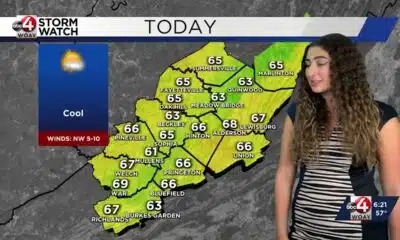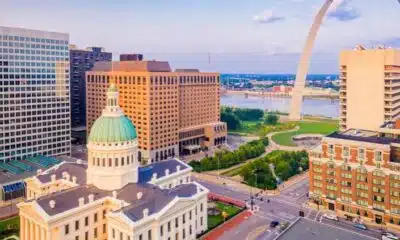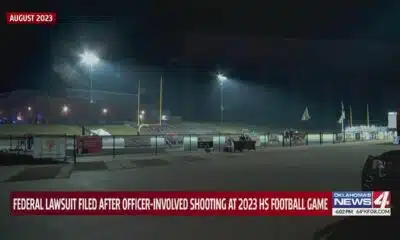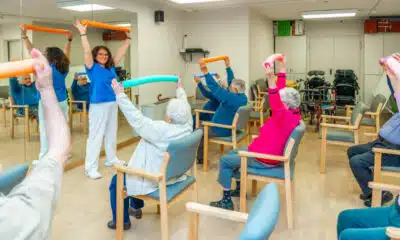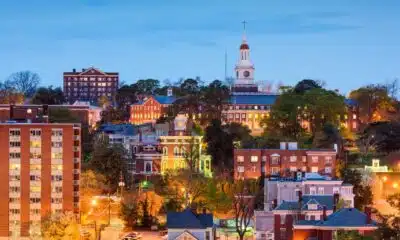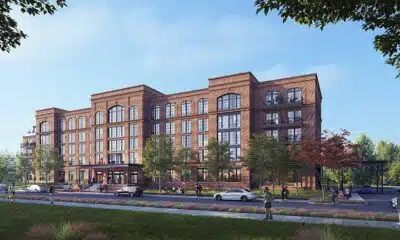News from the South - Louisiana News Feed
Since Katrina, infrastructure shortcomings create resiliency fatigue
by Elise Plunk, Louisiana Illuminator
August 26, 2025
An American flag has been strategically placed on one of the massive beams supporting the Lake Borgne Surge Barrier, part of the New Orleans region hurricane and storm damage risk reduction system.
Completed in 2009 to close off the Mississippi River Gulf Outlet, the barrier is designed to decrease damage to the metropolitan area when a major hurricane pushes water from the Gulf of Mexico into the lakes that surround the city and neighboring parishes.
The flag on the wall symbolizes pride and mourning, a reminder of the people it protects and a memorial for those who died 20 years ago when Hurricane Katrina hit. The failure of the federal levee system Aug. 29, 2005, claimed more than a thousand lives, displaced nearly a million people in the region and left permanent scars on New Orleans.
A go-to term emerged to praise New Orleanians and their neighbors who persevered through the catastrophe and took part in the unprecedented rebuilding: resilient. But as various recovery programs faltered and efforts to ensure disaster history would not repeat itself stalled, “resilient” or “resiliency” now elicit bitter feelings among locals.
“I think people have gotten tired of the word. Not just because it’s become cliché, but because people have begun to understand it as an excuse for lack of preparation or execution, lack of planning or execution,” said Michael Hecht, CEO and president of Greater New Orleans Inc., a regional economic development group.
Hecht came to Louisiana in 2006 from New York, where he led a 9/11 small business recovery program for New York Mayor Michael Bloomberg. After directing the state’s post-Katrina business recovery efforts, he was chosen to lead GNO Inc. in 2008.
“We had been knocked down by an unprecedented event,” Hecht said. “It was either be resilient or die, so we were resilient.”
The world has watched as New Orleans fundamentally changed, having lost a significant portion of its Black working class and attracting an upsurge in mostly white transplants from out of state. With more than 484,000 residents before Katrina, the city’s population plummeted below 344,000 in the 2010 census. The number climbed above 391,000 in 2020 and has since fallen about 4% as of 2024, according to various estimates.
Most who have stayed are ardent defenders of the city’s culture, of which resiliency fatigue is quickly becoming a feature. It’s reflected in Louisiana’s slow progress to rebuild coastal land and improve the adaptability of cities to match what post-Katrina boosters envisioned.
GET THE MORNING HEADLINES.
Restoration resistance
After Katrina, more emphasis was placed on rebuilding Louisiana’s vanishing coastal wetlands to protect residents from the increasing threat of hurricanes. A state Coastal Master Plan has taken shape over the past two decades, gaining official approval in 2023, to tie together restoration efforts and shield wetlands from sea level rise, subsidence and worsening hurricanes.
“We learned from Hurricane Katrina that levees alone aren’t enough,” said Alisha Renfro, a coastal scientist with National Wildlife Foundation. “We also need a healthy natural ecosystem sitting out in front of those levees to protect the structures that protect our communities.”
But the master plan encountered a huge setback in July with the end of what had been its keystone project, the Mid-Barataria Sediment Diversion project. Gov. Jeff Landry led pushback against the project for its feared impact on fisheries and nearly $3 billion price tag.
So far, the state’s Coastal Restoration and Protection Authority has spent $600 million to harness the power of the Mississippi River to bring fresh water and sediment to wetlands in the Barataria Basin – only to shelve the diversion.
“It was probably one of the most innovative, forward-thinking things in terms of being a resilience hub for the world,” said Amanda Moore, senior director for the National Wildlife Federation’s Gulf program.
A lifetime Gulf Coast resident, Moore moved to New Orleans from the Tampa, Florida, area in 2009 to take a job as a community organizer with the National Wildlife Federation. She joined the wave of thinkers, scientists and planners who came to the city after Katrina with the hope of bringing relief from the constant threat of flood.
“For people who live on the Gulf Coast – and especially South Louisiana – it’s exhausting,” she said.
The federation was among the voices that influenced upgrades to the region’s storm risk reduction system in the years after Katrina. Moore led efforts such as the MRGO Must Go Coalition, advocating for reversal of wetlands damage attributed to saltwater intrusion from the Mississippi River Gulf Outlet.
“You’re helping to alleviate maybe some of that exhaustion that people are personally feeling when you do the coastal restoration,” Moore said. “You’re adding this layer of protection, you’re helping it create a healthier environment that’s safer, so that does help people really be more resilient and not burnt out.”
Funding momentum peters out
As Katrina and its aftermath garnered worldwide attention, the recovery money streamed in from Washington and charitable foundations. The federal government directed $76 billion to Louisiana projects.
But keeping up the pace of investment after post-disaster attention spans waned became a problem for state and local leaders. Even with billions of dollars put into infrastructure, billions more would be needed for upkeep and replacing outdated systems. Stormwater drainage and drinking water in New Orleans, for example, rely on a power supply and mains that, in many spots, are more than a century old.
Charles Allen, Gulf Coast community engagement director for the National Audubon Society, recalls the vast amounts of federal and philanthropic dollars directed to the region in the years immediately after Katrina – and the dropoff that followed. It revealed the inability of state and local governments to sustain the level of rebuilding needed.
“It’s like anything in life, you know?” Allen said. “We gotta maintain our bodies, and we have to invest in whatever it takes to do that.”
The 2010 explosion of the Deepwater Horizon just off the Southeast Louisiana coast reopened wounds in the region that had yet to heal from Katrina’s trauma. Like the levee failures after the hurricane, It was considered another manmade, preventable disaster. Eleven crew members were killed, and the catastrophic oil spill tainted wildlife and habitat in all five Gulf Coast states. Livelihoods that depended on the Gulf were sidetracked for months, if not ended entirely.
Petroleum giant BP, which contracted the drillship, reached a $20 billion settlement with the federal government and impacted states. In Louisiana, it provided the long-sought financial foundation for its coastal master plan.
But with the Mid-Barataria Sediment Diversion shelved – and seemingly no other major restoration projects in the queue – Allen and others with vested interest in coastal flood protection fear Louisiana has become dependent on disaster recovery funding to pay for critical infrastructure that should already be in place.
“Let’s not wait for another storm because then it’s always too late when that happens,” Allen said “You gotta invest in it, you gotta support it, you’ve got to fund it.”
“It’s a lot of reactive disaster-related funding that’s allowing Louisiana to do this work,” Moore said. “We’ve got to figure out how to get out of that cycle.”
‘People can just be people’
Katrina recovery funds paid for upgrades to the massive pumping stations at the end of New Orleans’ outfall drainage canals that pump stormwater into Lake Pontchartrain. Beyond that, however, the city hasn’t engineered a way to handle street flooding from routine heavy rainstorms.
One project was held up as a way for New Orleans to adapt to the regular influx of rainwater, rather than fruitlessly attempt to pump it away. The Gentilly Resilience District called for turning neutral grounds in the neighborhood into retention areas. Residents would be encouraged to add features such as rain cisterns and permeable driveways, with grants to cover their cost.
The centerpiece of the district was the Mirabeau Water Garden, planned for 25 acres of land that were once home to a Catholic convent. The Congregation of the Sisters of St. Joseph donated the land to the city in 2015 on the condition it be used to enhance and protect the neighborhood. It was designed to divert and hold up to 10 million gallons of stormwater in ponds and constructed wetlands, with a pedestrian path and other amenities to invite the public into the space.
The architecture firm Waggonner and Ball designed the water garden using best practices for how to integrate water into a coastal urban setting. The idea came out of a trans-Atlantic collaboration after Katrina called the Dutch Dialogues, in which New Orleans experts tapped into the Netherlands’ experience living with water.
The federal government provided $141 million to the city in 2017 to bring the Gentilly Resilience District to life, with a completion date set for September 2022. But as of 2023, the U.S. Department of Housing and Urban Development noted that only 15% of the money had been spent. The water garden remains largely unfinished.
HUD’s inspector general designated the city a “slow spender” in a project audit, noting that its elements “did not always improve the program participants’ ability to withstand future extreme events.”
In addition to his role with GNO Inc., Hecht was named chairman of the governor’s committee to prepare New Orleans for the 2025 Super Bowl, played in February at the Superdome. Part of Hecht’s charge was to track progress on city infrastructure projects. And while the Gentilly Resilience District is well outside the city’s tourist zone, its lack of progress was noticeable.
“It’s happening. It’s been accepted as a concept, but it’s been extremely slow,” Hecht said. “And that’s just been execution failure, oftentimes on the part of the city.”
The communications team for the city of New Orleans did not respond to a request for comment on the timeline of finishing the Mirabeau Water Gardens.
The Mirabeau Water Garden’s status is considered by residents to be symbolic of New Orleans falling well short of the post-Katrina vision that boasted resilience as a key component of its new economy. Much like the Netherlands, it was thought that the Crescent City could become a beacon of expertise for how to adapt to climate change.
“We thought we were going to be able to really build a sector around selling our experience post Katrina with water management and environmental management around the world,” Hecht said. “If we’re being honest, it has not materialized much as part of our economy.”
It has happened in a small way, he said, citing the Water Institute in Baton Rouge. The independent research center focuses on the Mississippi River Delta and Gulf Coast, and it has applied its expertise to several projects in the region.
“But I think there’s still a lot more,” Hecht said.
Allen believes the opportunity to make Louisiana that hub of water management and resilience still exists, but he acknowledged it is still far from materializing 20 years after Katrina.
“This story of restoration, it’ll never end, which is a good thing,” Allen said. “This kind of work fuels jobs, environmental research and teaching.”
Until or unless that sector develops, the vulnerability of southeast Louisiana to future disasters will continue to place a strain on its residents, observers say, and climate change only heightens that risk.
“That is the goal … building structures, either literally or metaphorically, strong enough so that in a world with climate change and weather volatility, when things happen, either natural or man made, we don’t have to be resilient,” Hecht said.
Renfro, the coastal scientist with the National Wildlife Federation, said it’s wrong to keep placing the same burden of recovery on a population forced to accept conditions beyond their control.
“Asking the same people again and again to be resilient … it feels unfair,” she said. “People can just be people, and infrastructure can be resilient.”
YOU MAKE OUR WORK POSSIBLE.
Louisiana Illuminator is part of States Newsroom, a nonprofit news network supported by grants and a coalition of donors as a 501c(3) public charity. Louisiana Illuminator maintains editorial independence. Contact Editor Greg LaRose for questions: info@lailluminator.com.
The post Since Katrina, infrastructure shortcomings create resiliency fatigue appeared first on lailluminator.com
Note: The following A.I. based commentary is not part of the original article, reproduced above, but is offered in the hopes that it will promote greater media literacy and critical thinking, by making any potential bias more visible to the reader –Staff Editor.
Political Bias Rating: Center-Left
This content primarily focuses on the environmental, social, and governmental challenges faced by New Orleans post-Hurricane Katrina. It highlights the shortcomings of government and infrastructure in adequately preparing for and responding to disasters, emphasizes the need for investment in sustainable and natural coastal restoration efforts, and discusses social issues like demographic changes and economic recovery. The article critiques political and administrative decisions, such as the shelving of major restoration projects and slow spending of federal funds, from an angle that favors proactive climate resilience, environmental protection, and equitable recovery efforts—stances typically associated with center-left perspectives. However, it avoids overt partisanship or ideological rhetoric, maintaining a fact-based and nuanced approach.
News from the South - Louisiana News Feed
Monday Noon Tropics Update: Fernand heads north, Invest 99 fizzles
SUMMARY: Tropical Storm Fernand is improving in organization with 60 MPH winds but faces increasing wind shear and cooler waters as it moves north, likely weakening by Wednesday without threatening land. Invest 99 in the eastern Caribbean remains disorganized with strong wind shear, leading the National Hurricane Center to drop its development chance to 0%. The hurricane season has reached Fernand, with Gabrielle and Humberto next on the list, though no new formations are expected soon. Approaching the peak hurricane season around September 10, activity is likely to continue through September, with cooling temperatures and increased rain chance as fall approaches.
Meteorologist Alexandra Cranford tracks Tropical Storm Fernand and Invest 99 at noon on Monday, August 25, 2025.
News from the South - Louisiana News Feed
Fox 14 Your Morning News: Movement Monday
SUMMARY: Fox 14 Your Morning News’ Movement Monday features partner exercises focused on fun and fitness. The segment includes reverse lunges, one-legged squats, and partner high-five squats to build strength and balance. They use a ball or pillow for back-to-back seated twists and tossing exercises to engage the core. The workout ramps up with side-to-side knee kicks and ab work to boost abdominal strength. Lastly, partners perform planks combined with cardio moves like jumping through feet, emphasizing proper form, breathing, and rhythm to maximize calorie burn and stability. The lively, encouraging approach makes fitness enjoyable and accessible.
Amy returns for another lively installment of ‘Movement Monday,’ which includes a variety of exercises such as reverse lunges, one-legged squats, and planks, all aimed at promoting fitness and teamwork.
News from the South - Louisiana News Feed
Extreme heat in prisons brings more legal challenges, pressure on states
by Amanda Hernández, Louisiana Illuminator
August 25, 2025
Summer heat is bearing down on U.S. prisons, where temperatures in uncooled cells can climb well into the triple digits.
Facing growing pressure from advocacy groups, lawsuits and climate projections that show hotter days ahead, some state prison systems are moving to install air conditioning and expand cooling measures — though many facilities remain years away from significant upgrades.
But in other states, such efforts have stalled or failed. That may lead to more lawsuits in the future, experts say, even as judges may raise the bar for such cases.
An emphasis on being “tough on crime” and prioritizing other public safety measures may have contributed to less attention on prison conditions in some states. In others, slowing revenue growth and pressure to rein in corrections spending could be making new investments a harder sell.
At least two states this year, Virginia and Texas, considered legislation addressing excessive heat in prisons but neither measure became law. The Texas bill would have required the state Department of Criminal Justice to purchase and install climate control systems in all of its facilities by the end of 2032. About two-thirds of the state’s correctional facilities have only partial or no air conditioning.
The measure passed the House but did not advance in the Senate before the legislature adjourned in June.
GET THE MORNING HEADLINES.
In Virginia, lawmakers approved a bill that would have required the state corrections department to install heat and air conditioning in its prisons and to ensure cell temperatures not exceed 80 degrees. Republican Gov. Glenn Youngkin vetoed it, citing the cost of installation and operational burdens. Youngkin also wrote that existing state corrections data “does not substantiate the claims of extreme temperatures or health risks.”
But in Delaware, the fiscal year 2026 capital budget approved last month includes $2 million in funding to install air conditioning at the James T. Vaughn Correctional Center.
These changes mark the latest actions in a long-running debate over how correctional systems respond to rising summer temperatures — an issue that affects both incarcerated people and staff. Some of the policy debates and facility updates this year follow years of advocacy and litigation over the health, safety and operational challenges posed by heat in correctional settings.
The problem of excessive heat in prisons has persisted for decades and has unfolded alongside other challenges, including chronic understaffing and overcrowding. In some cases, these problems have led to extended facility lockdowns, even during the summer months.
“There are people working in prisons and they have the right to work in climates that are comfortable,” said Nancy La Vigne, a criminal justice researcher and dean of the School of Criminal Justice at Rutgers University. “When they’re not, there’s retention issues, and it’s hard to replace staff. And when you don’t replace staff, then you have challenges in maintaining the safety and security of the facility.”
In New York, for example, correctional officers staged a three-week strike earlier this year and many didn’t return to work. Some facilities now are operating with 30%-60% fewer guards than needed, resulting in some incarcerated people getting only an hour or two outside of their cells each day.
A 2023 study published in the peer-reviewed PLOS One journal found that mortality in state and private prisons rose during periods of extreme heat, with deaths increasing 3.5% on extreme heat days and up to 7.4% during three-day heat waves. Between 2001 and 2019, nearly 13,000 people died in prison during the summer months, almost half of them in the South, though the study did not determine how many of those deaths were directly attributable to heat.
Climate change is fueling longer, more intense periods of extreme heat. Exposure to extreme heat can worsen conditions such as cardiovascular disease, diabetes and asthma, and has also been linked to worsening mental health and higher suicide rates among incarcerated people.
“Average temperatures are rising, and you’re going to have more and more states around the country where incarcerated people are held in conditions that are not livable because they’re too hot,” said Sharon Dolovich, a law professor and director of the Prison Law and Policy Program at the University of California, Los Angeles.
Some upgrades
At least 44 states lack universal air conditioning within their prison facilities, even in regions known for sweltering summer temperatures, according to a 2022 USA Today analysis. A recent Reuters investigation also found that nearly half of state prisons across 29 states have partial or no air conditioning in housing units.
But some states are investing millions to update their prison facilities.
In North Carolina, corrections officials are working toward their goal of installing air conditioning in all 54 state prisons by 2026. To date, 33 facilities are fully air-conditioned, 17 are partially air-conditioned, and four have no air conditioning, according to its dashboard.
In California, the Department of Corrections and Rehabilitation, which operates 31 adult prisons, has spent $246 million in the past five years on cooling improvements at five prisons, according to a department spokesperson.
Lawmakers this year also approved funding for the Air Cooling Pilot Program at three facilities, with $17.6 million allocated for fiscal years 2025-26 and $20 million for fiscal years 2026-27. It will evaluate the effectiveness of two alternatives prior to a statewide plan to address high indoor temperatures across the California prison system.
The Texas Department of Criminal Justice, as of Aug. 1, is building 12,827 “cool beds,” or prison cells in air-conditioned units, and is in the process of procuring an additional 7,162, according to its dashboard.
Texas is one of the states most closely associated with heat-related deaths in prison. A 2022 study estimated that, on average, 14 deaths per year in Texas prisons are associated with heat. And a Texas Tribune analysis found that at least 41 incarcerated people died during a record-breaking heat wave in 2023.
In March, a federal judge ruled the extreme heat in Texas prisons is “plainly unconstitutional,” but declined to order immediate air conditioning, saying the work could not be completed within the court order’s 90-day window and temporary systems might delay a permanent fix.
‘More miserable’
Sweltering summer heat can turn prisons into pressure cookers. People inside already may have health conditions, limited access to cooling, or take medications that make it harder for their bodies to handle the heat. And research suggests that high temperatures can heighten irritability and aggression, sometimes fueling more conflicts between incarcerated people or with staff.
“It makes you more miserable. … If you to the point of even thinking about suicide, that’s just going to add to it,” said Ronald McKeithen, who spent 37 years incarcerated in Alabama prisons and is now the director of second chances at the Alabama Appleseed Center for Law and Justice. McKeithen recalls feeling “on edge” due to tension among other incarcerated people on hot days.
At the Oshkosh Correctional Institution in Wisconsin, Devin Skrzypchak said the heat worsens his bladder condition, and he often can’t get the incontinence briefs he needs. The heat forces him to drink more water, and on days when ice isn’t available, he’s left drenched in sweat.
“At times, it’s a living hell. … It can be very excruciating,” Skrzypchak wrote in a message to Stateline through the facility’s messaging platform.
D’Angelo Lee Komanekin — who has spent about 25 years in and out of different Wisconsin corrections facilities — said prison architecture plays a major role in why temperatures inside climb so high.
“The planet is getting hotter and hotter,” said Komanekin, who relies on a small plastic fan to stay cool. Komanekin also is incarcerated at the Oshkosh Correctional Institution. “They’re doing nothing about the architecture. Some institutions’ windows open, some don’t, but most of the doors have steel doors with trap doors.”
Older prison designs that rely heavily on steel and concrete building materials often trap heat, making it difficult to keep temperatures down in the summer. Aging facilities also are less likely to be equipped for the installation of central air conditioning.
Some state prison systems, including Alabama’s and Wisconsin’s, are adding air-conditioning or air-tempering systems to new prison construction and major renovation projects.
Future legal battles
Legal experts say the issue of excessive heat in prisons is likely to become more pressing as climate change drives longer and hotter summers.
Extreme heat in correctional facilities has already been the subject of litigation in dozens of states, with plaintiffs arguing that high temperatures constitute cruel and unusual punishment under the Eighth Amendment. Court rulings in these cases have varied, but some experts say even more lawsuits are likely if facilities do not adapt.
“The conditions are going to worsen. [Incarcerated people are] going to be looking for every possible avenue for assistance they can,” Dolovich, the UCLA law professor, told Stateline.
One of the latest cases comes from Missouri, where the nonprofit law firm MacArthur Justice Center filed a class-action lawsuit in May on behalf of six incarcerated people at Algoa Correctional Center.
The lawsuit alleges that the conditions violate their constitutional rights under the Eighth Amendment. It seeks to require the Missouri Department of Corrections to work with experts to develop a heat mitigation plan that keeps housing unit temperatures between 65 and 85 degrees. If the department cannot meet that standard, the plaintiffs are asking for the release of three of the incarcerated people who have less than a year remaining on their sentences.
Lawsuits such as the Missouri case often focus on claims that extreme heat worsens existing medical problems. To proceed, they must meet two legal requirements: proving the heat poses a serious health or safety risk, and showing prison officials knew about the danger but failed to address it, according to Dolovich, whose work has focused on the Eighth Amendment and prison conditions.
Courts may also raise the bar for proving such claims if judges echo decisions in cases with similar Eight Amendment arguments related to the death penalty and homelessness, Dolovich said. Judges have shifted, she said, toward a “superadding terror, pain and disgrace” standard under the Eighth Amendment — a higher threshold requiring proof that conditions were created with the intent to cause unnecessary suffering.
Dolovich added that some recent court decisions have provided only narrow remedies, such as ordering ice and fans instead of installing air conditioning.
“Prison officials have a moral and a constitutional responsibility to respond to changing conditions. In this case, it means air conditioning. … Anything less than that, to me, is indefensible.” she said.
Stateline reporter Amanda Hernández can be reached at ahernandez@stateline.org.
YOU MAKE OUR WORK POSSIBLE.
This report was originally published by Stateline, part of the States Newsroom nonprofit news network. It’s supported by grants and a coalition of donors as a 501c(3) public charity. Stateline maintains editorial independence. Contact Editor Scott S. Greenberger for questions: info@stateline.org.
Louisiana Illuminator is part of States Newsroom, a nonprofit news network supported by grants and a coalition of donors as a 501c(3) public charity. Louisiana Illuminator maintains editorial independence. Contact Editor Greg LaRose for questions: info@lailluminator.com.
The post Extreme heat in prisons brings more legal challenges, pressure on states appeared first on lailluminator.com
Note: The following A.I. based commentary is not part of the original article, reproduced above, but is offered in the hopes that it will promote greater media literacy and critical thinking, by making any potential bias more visible to the reader –Staff Editor.
Political Bias Rating: Center-Left
This article focuses on the human and constitutional costs of inadequate climate control in U.S. prisons, highlighting health risks, lawsuits, and advocacy efforts for improved conditions. It presents facts and critiques the failure of some states, particularly those with conservative leadership, to act on air conditioning installation, framing these failures in terms of moral responsibility and human rights. While it remains largely factual and balanced, the emphasis on systemic issues within prisons, climate change impact, and critiques of financial and political obstacles—especially mentioning vetoes by Republican governors—indicates a center-left leaning perspective, which tends to prioritize social justice, human rights, and governmental intervention to address public welfare challenges.
-
News from the South - Alabama News Feed7 days ago
U.S. agriculture secretary announces end to subsidies for solar panels on farmland
-
News from the South - Kentucky News Feed6 days ago
First of its kind clinical trial offers new hope for Kentuckians at risk of dementia
-
News from the South - Arkansas News Feed7 days ago
Cities across the US are embracing AI guidelines for local government workers
-
News from the South - Georgia News Feed7 days ago
Don't eat this shrimp sold at Walmart due to possible radiation contamination: FDA
-
News from the South - Alabama News Feed6 days ago
Grants to boost local emergency alert systems in question as public media agency closes
-
News from the South - Arkansas News Feed6 days ago
‘Alligator Alcatraz’ probed by Dems as ICE detention centers multiply in states
-
Our Mississippi Home6 days ago
MSU Unveils Mixed-Use Development Featuring Boutique Hotel, Cultural Landmark
-
News from the South - Arkansas News Feed5 days ago
New I-55 bridge between Arkansas, Tennessee named after region’s three ‘Kings’

